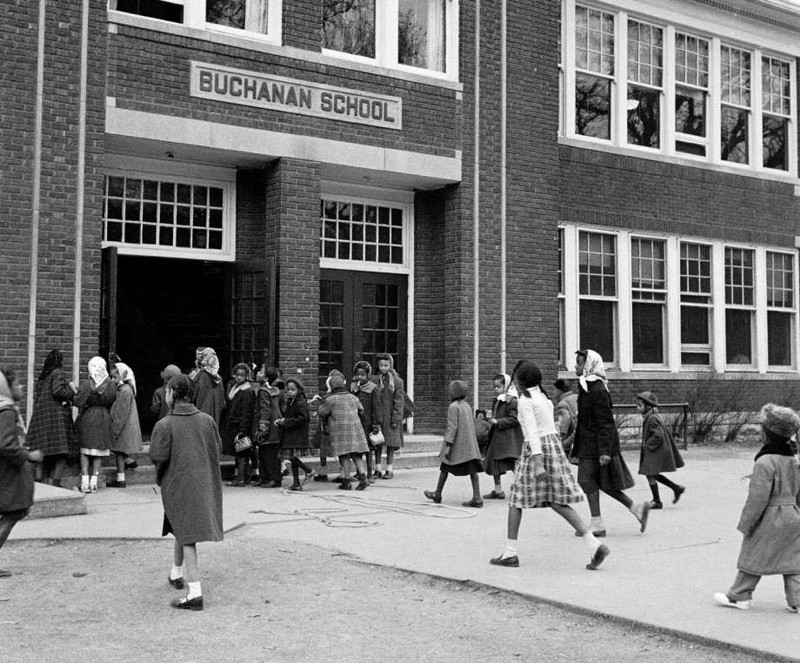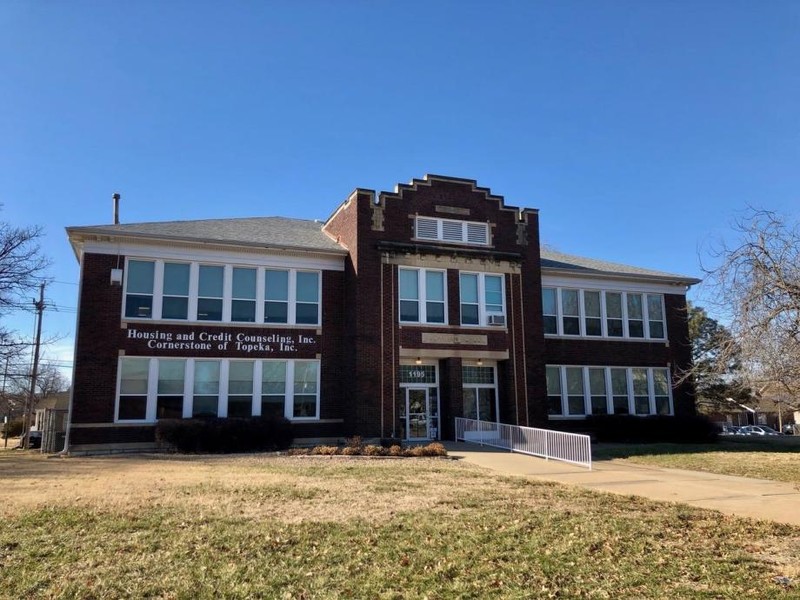Buchanan Elementary School
Introduction
Text-to-speech Audio
Built in 1885, Buchanan Elementary was a cornerstone of the Topeka's Black "Tennessee Town" Community. In 1893, Reverend Dr. Charles Sheldon opened Topeka's first free kindergarten in Tennessee Town, which moved to Buchanan Elementary School in 1910. By the time of the Brown v Board of Education lawsuit in the 1950s, Buchanan Elementary School operated as one of Topeka's four African American elementary schools. However, despite the abundance of positives emanating from segregation, the landmark court case and consequent desegregation did alter life within Black enclaves and affect their schools; Buchanan closed in 1959, and many Black teachers lost their jobs.
Images
Buchanan Elementary School

The former Buchanan Elementary School

Backstory and Context
Text-to-speech Audio
In 1902, William Reynolds, a Black resident of Topeka, attempted to admit his son to the newly constructed Lowman Hill School, but the school turned Reynolds away. Instead, officials ordered Reynolds' son and the district's other African American children to attend an old, dilapidated two-room wooden structure. Reynolds responded by filing a lawsuit claiming that the separation of children by race violated the Fourteenth Amendment of the U.S. Constitution and the condition in the state constitution that required the establishment of a uniform system of schools. Kansas' highest court disposed of Reynolds' claims finding that the city's educational system was consistent and equal for Blacks and Whites regardless of whether they were separated. In short, the court legalized the principle of "separate but equal."
The results of the Reynolds case led to a slow process of segregating Topeka's school system. From 1908 to 1924, the city school board struggled to provide for all its schools as its total student population climbed from 6,216 to 13,811. The lack of teachers in African American schools forced principals to teach full-time rather than perform their administrative duties. Schools in African American communities also had to deal with Southern migrants arriving without previously receiving a proper education, straining teachers further. Meanwhile, overcrowding in both White and Black schools handcuffed the school board; they could not move Black students from White schools to Black schools despite outcries from some White residents.
The passage of an $850,000 bond in the 1920s finally allowed the city to move towards a fully segregated school system. The school board launched an ambitious construction program, building four Black and eighteen White elementary schools. Deeming schools all equal and sufficient to provide quality education, the board determined that the 1928 - 1929 school year would be the last in which Black and White children would attend school together. But, not everyone agreed with the new policy, notably because Black students often had to travel much farther to their schools than White children. Several lawsuits were quickly filed protesting the segregation philosophy, including one aided by the Topeka Chapter of the National Association for the Advancement of Colored People (NAACP). The NAACP-supported case is the only one that made it to court, but the court ruled in favor of the defendant (school board), and the Kansas Supreme Court also decided in favor of the school board.
Few challenged the school segregation issue during the Great Depression, but a new challenge arose in 1941 in the Graham v. The Board of Education of Topeka case. The Graham case shed light on the difference in programs for Black and White students beyond the sixth grade. White students attended three years of junior high school (grades seven through nine), while Black students continued in elementary school for seventh and eighth grades and then transferred to a junior high school for ninth grade. The Kansas Supreme Court ruled in favor of Graham, citing the different systems as discriminatory.
The Graham case ostensibly served as the first step towards desegregation, but not everyone in the African American community celebrated it as progress. Many within the Black community wanted to fight to protect the jobs of Black teachers, while others did not want their children to attend a White school. Still, many within the African American community, including influential people at the NAACP, felt it necessary to address the broader argument of treating African Americans differently than White Americans. The debate, both within the Black community and among Whites and Blacks, continued throughout the 1940s and into the 1950s, including after the infamous Brown v. Board of Education case that ultimately ended segregation nationwide in 1954. As many within the African American neighborhoods feared, Black school teachers, because of integration, lost their jobs despite many of them holding advanced degrees. In short, while students integrated, only a few African American teachers gained employment in formerly all-White schools. And, in the case of Buchanan Elementary, the entire school closed in 1959.
Sources
"African American Teachers in Kansas." Kansas Historical Society. December 2017. https://www.kshs.org/kansapedia/african-american-teachers-in-kansas/11995.
"Brown Sites in Topeka: Buchanan Elementary School." The Brown Foundation. Accessed April 3, 2023. https://brownvboard.org/content/buchanan-elementary-school.
"Buchanan Elementary School." Visit Topeka. Accessed April 3, 2023. https://www.visittopeka.com/things-to-do/the-crossroads-to-freedom/african-american-history/buchanan-school/.
Hrenchir, Tim. "How effectively is Topeka sharing its Black history? Educators, historians share contrasting views." Topeka Capital-Journal. cjonline.com. February 27, 2022. https://www.cjonline.com/story/news/2022/02/27/opinions-vary-regarding-how-well-topeka-kansas-teaching-sharing-its-black-history/6941127001/.
Mollie, Pamela G. "A Look at the Brown Case 25 Years Later." New York Times. May 16, 1979. https://www.nytimes.com/1979/05/16/archives/a-look-at-the-brown-case-25-years-later.html.
"Prelude to Brown - 1941: Graham v. Topeka." The Brown Foundation. Accessed April 3, 2023. https://brownvboard.org/content/prelude-brown-1941-graham-v-topeka.
Rosenblum, Thom. "The Segregation of Topeka's Public School System, 1879-1951." National Park Service. March 21, 2023.
https://www.visittopeka.com/things-to-do/the-crossroads-to-freedom/african-american-history/buchanan-school/
https://www.visittopeka.com/things-to-do/the-crossroads-to-freedom/african-american-history/buchanan-school/
